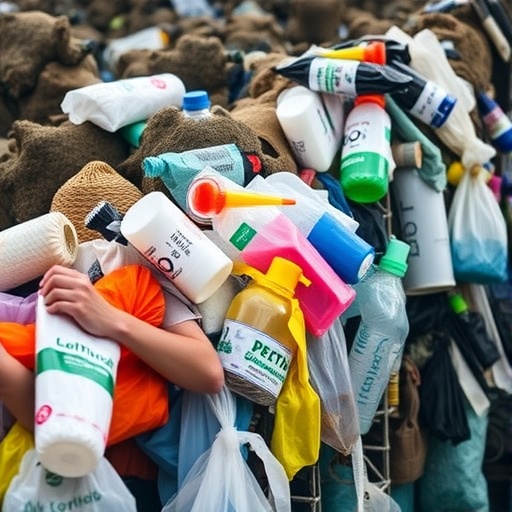In a groundbreaking initiative highlighting the escalating health risks posed by plastic pollution, a coalition of international experts has called for urgent attention to the multifaceted impacts of plastics on human well-being. This call accompanies the launch of the Lancet Countdown on Health and Plastics, a pioneering project designed to systematically track and monitor the adverse health consequences linked to plastics throughout their entire life cycle. The initiative arrives as the global community anticipates the finalization of a United Nations global plastics treaty, emphasizing that health considerations must become a central pillar in international environmental policy and plastic governance.
Plastic production, an industry that has expanded exponentially since the mid-20th century, is forecasted to nearly triple between 2019 and 2060 if current trends persist. This dramatic increase underscores the urgency of understanding the comprehensive health implications associated with plastics, which permeate every phase from manufacturing to disposal. The recently published review in The Lancet meticulously synthesizes existing scientific evidence, revealing that plastics contribute to a diverse array of harmful exposures and health challenges, particularly through airborne emissions, chemical exposures, environmental contamination, and indirect ecosystem disruptions.
Central to these findings is the identification of hazardous pollutants emitted during plastic production. Factories engaged in polymer synthesis and related processes release a cocktail of fine particulate matter, notably PM2.5, along with sulfur dioxide (SO2) and nitrogen oxides (NOx). These pollutants are well-documented contributors to respiratory and cardiovascular disease and pose significant occupational hazards to workers in plastic manufacturing facilities. The complex chemical formulations of plastics often remain underregulated and obscure, complicating the assessment of potential toxicity and risks posed to both workers and surrounding populations.
Compounding these concerns is the pervasive presence of microplastics—minuscule plastic particles less than 5 millimeters in diameter—that have infiltrated virtually every conceivable environmental niche. Recent analytical advancements have detected microplastics within human tissues and bodily fluids, a startling revelation that raises profound questions about the long-term health consequences of chronic exposure. Although research is ongoing to elucidate the mechanisms and extent of harm microplastics may inflict, precautionary principles advocate for immediate action given preliminary evidence suggesting inflammatory responses, oxidative stress, and possible disruption of cellular homeostasis.
The disposal phase of plastics presents its own suite of hazards. It is estimated that approximately 57 percent of unmanaged plastic waste is subjected to open burning, particularly in low- and middle-income countries. This practice releases toxic compounds including dioxins, furans, and other persistent organic pollutants that exacerbate ambient air pollution and contribute to a wide spectrum of illnesses, ranging from acute respiratory infections to long-term carcinogenic risks. The intersection of waste management deficiencies and resultant health burdens illustrates stark environmental justice concerns, disproportionately affecting vulnerable and marginalized communities.
Beyond direct toxicological impacts, plastic waste exerts subtle yet consequential influences on the epidemiology of infectious diseases. Discarded containers and debris serve as breeding grounds for vector organisms like mosquitoes, facilitating the transmission of diseases such as malaria, dengue, and Zika virus disease. Moreover, plastic pollution fosters environmental conditions conducive to the proliferation of antimicrobial-resistant microorganisms, further complicating the global challenge of infectious disease control and threatening to undermine decades of progress in antibiotic stewardship.
The Lancet Countdown on Health and Plastics is structured to apply a rigorous, indicator-based framework, similar to its predecessor focused on health and climate change. This framework will enable the systematic collection, analysis, and dissemination of data relating to plastic-associated health risks across different domains and geographies. With the inaugural indicator report slated for release in mid-2026, this initiative promises to furnish policymakers, researchers, and the public with reliable metrics essential for informed decision-making and accountability.
One critical knowledge gap highlighted by the review pertains to the transparency and disclosure surrounding the chemical composition of plastic materials. Industry practices often withhold detailed information on chemical additives, flame retardants, plasticizers, and stabilizers that may have toxicological profiles affecting endocrine, neurological, and reproductive health. The lack of comprehensive chemical inventories impedes regulatory oversight and hinders epidemiological studies aimed at linking specific chemicals to observed health outcomes.
Scientific discourse also underscores the need for interdisciplinary collaboration bridging environmental science, toxicology, epidemiology, and public health. As plastics intertwine with climate change, ecosystem integrity, and social determinants of health, holistic approaches are required to untangle complex exposure pathways and synergistic effects. This multidimensional perspective will better position global health governance frameworks to prioritize prevention and mitigation strategies that address the root causes of plastic-related health threats.
Furthermore, the socio-economic ramifications of plastic pollution-related health burdens cannot be overstated. The increased incidence of diseases attributable to plastic pollutants carries profound implications for healthcare systems, labor productivity, and economic resilience, especially in countries grappling with limited resources. Investments in sustainable alternatives to plastic production, enhanced waste management infrastructures, and community education programs are indispensable to breaking the cycle of pollution and health deterioration.
Expert stakeholders underscore that mitigation efforts must extend beyond the traditional focus on environmental conservation to explicitly integrate human health metrics. This paradigm shift will catalyze the development of more stringent international regulations, incentivize innovation in biodegradable and non-toxic materials, and amplify advocacy for policies that curtail plastic consumption and promote circular economy principles.
In conclusion, the Lancet Countdown on Health and Plastics sets a transformative agenda by systematically illuminating the interconnected health ramifications of plastic pollution. As global plastic production surges and health consequences become increasingly evident within populations worldwide, this effort represents a critical step in elevating the issue within public health discourse and international environmental governance. The initiative’s forthcoming comprehensive indicators and robust data dissemination will empower stakeholders to implement effective interventions, guiding the world toward a healthier, more sustainable relationship with plastic materials.
Subject of Research: Not applicable
Article Title: The Lancet Countdown on health and plastics
News Publication Date: 3-Aug-2025
Web References: Not provided
References: Not provided
Image Credits: Not provided
Keywords: Plastics, Synthetic polymers, Polymer engineering, Materials engineering, Applied sciences and engineering




